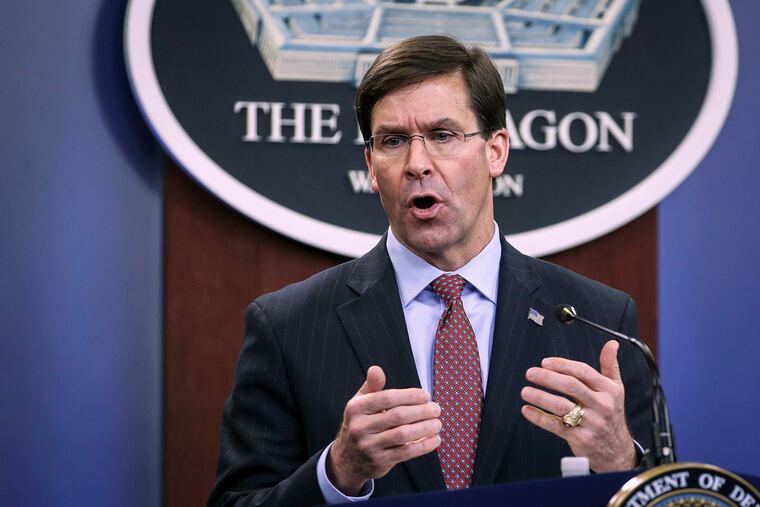Trump’s threat to strike Iranian cultural sites puts him in league with ISIS, Taliban | Trudy Rubin
The president should know that destroying Iran's cultural heritage sites would be a war crime and the hallmark of barbarians.

When the Taliban shattered the towering Buddhas of Bamiyan, Afghanistan, with hammers, spades, and explosives, the world’s religious and political leaders decried them as barbarians.
When ISIS smashed a Roman-era temple in the glorious, ancient Syrian city of Palmyra, the U.N. Security Council denounced them as destroyers.
So what do we call President Donald Trump for insisting last weekend that he could destroy cultural heritage sites to retaliate against Iran?
Even though by Tuesday afternoon the president had said, with clear reluctance, that he would “obey the law" — and even though his comments were overtaken by Iranian missiles flying over U.S. bases in Iraq — his initial threats to cultural sites should not be forgotten.
“Just the threat is quite amazing, coming from the president of the United States,” says Prince Zeid Ra’ad al Hussein, the former U.N. high commissioner for human rights, now a distinguished global leader at the University of Pennsylvania’s Perry World House. “This is a hallmark of the most extreme kind of movements or states, aligned with barbaric thuggery.”
» READ MORE: After Qassem Soleimani's killing, how does this war end? | Trudy Rubin
In one stroke, the president endorsed war crimes, further sullied America’s moral stature, and insulted the U.S. military. And he displayed total ignorance of what cultural heritage sites mean to the world.
Let’s start with the insult to the U.S. military. Doing intentional damage to cultural sites, save in cases of absolute military necessity, is a war crime, which violates a 1954 Hague Convention to which the U.S. is a party.
Yet Trump’s first instinct was to order U.S. troops to commit war crimes. “They’re allowed to blow up our people,” Trump said of Iran. “And we’re not allowed to touch their cultural sites. It doesn’t work that way.”
Yes, it does.
This careless, ill-informed remark ignored international law and U.S. military doctrine so blatantly that Secretary of Defense Mark Esper felt obliged to contradict the president by Monday evening, making clear that hitting cultural sites with no military value was a war crime.
“That’s the laws of armed conflict,” Esper said. And by Tuesday, the wave of criticism grew so great, including from leading GOP senators, that Trump backed off.
But the president was clearly ignorant about the larger significance of cultural heritage sites.
“Cultural heritage represents the record of our shared human experience, the archaeological remains from the past, and places that we revere in the present,” I was told by Brian Daniels, research director at the Penn Cultural Heritage Center of the University of Pennsylvania Museum and an expert on conflict and cultural loss. This is why threats to world heritage sites galvanize global attention.
It is also why, when the Taliban were destroying the 1,500-year-old Buddhas in Bamiyan, leaders worldwide tried (and failed) to stop them. And why those familiar with the desert splendor of Palmyra’s ruins (which I had the luck to visit) were distraught. Who can forget the brave efforts of Syrian antiquities scholar Khaled al-Asaad to save this ancient city, before he was beheaded by ISIS at age 82?
And it is why the idea of striking at any of Iran’s 22 UNESCO World Heritage sites is insane. As the former U.N. high commissioner points out: “Even someone totally against Qassem Soleimani’s Quds Force is proud of Persian culture.” A Trump strike on ancient Persian sites would turn all Iranians against him.
» READ MORE: Former U.N. human rights high commissioner on Trump, populism, complacency | Trudy Rubin
“The loss of any heritage site is devastating because it is part of your sense of being,” says Daniels. “The deep rootedness of cultural identity is why people mourn the loss.”
How ironic, then, that Secretary of State Mike Pompeo likes to tell the Iranian people, “We are with you.” Last Sunday, Pompeo insisted that Trump’s tweets didn’t say he’d go after cultural sites. Hourse later, Trump insisted he meant just that.
Equally ironic is that Trump’s threat came at a time when U.S. officials were doing more to protect international cultural heritage sites. That activity was propelled by memories of the looting of Baghdad’s National Museum, which U.S. forces failed to protect after the 2003 U.S. invasion.
The museum disaster helped prompt the United States to finally ratify the 1954 Hague Convention in 2009. Donny George, the brave museum director who tried to stem the looters in Iraq, came to UPenn’s museum for help in restoration.
“If Donny were alive, he would be shocked like the rest of us at Trump’s threat,” says Daniels. “Even if you don’t support the Iran regime, cultural heritage is something different.”
That is a difference Trump may never grasp, even if the Pentagon curbs him from acting on his instincts. Clearly culture, to him, has no meaning. And so he joins the barbarians who see cultural sites as fair game.